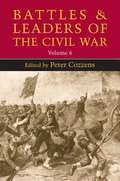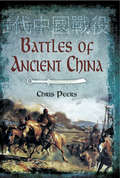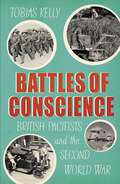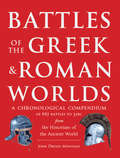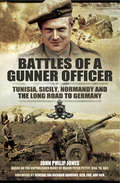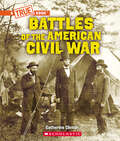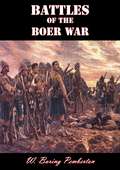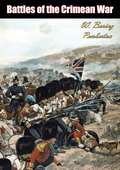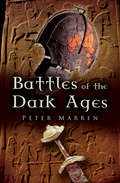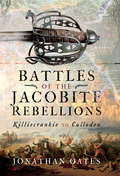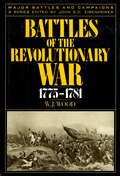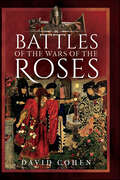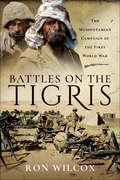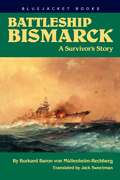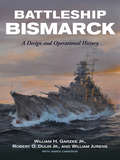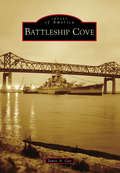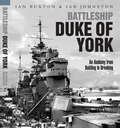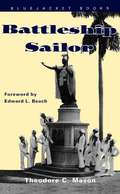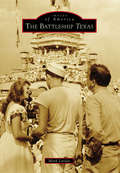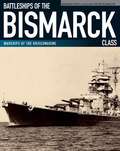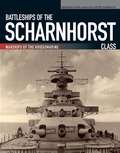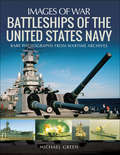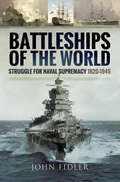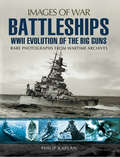- Table View
- List View
Battles and Leaders of the Civil War, Volume 6
by Peter CozzensSifting carefully through reports from newspapers, magazines, personal memoirs, and letters, Peter Cozzens' Volume 6 brings readers more of the best first-person accounts of marches, encampments, skirmishes, and full-blown battles, as seen by participants on both sides of the conflict. Alongside the experiences of lower-ranking officers and enlisted men are accounts from key personalities including General John Gibbon, General John C. Lee, and seven prominent generals from both sides offering views on "why the Confederacy failed." This volume includes one hundred and twenty illustrations, including sixteen previously uncollected maps of battlefields, troop movements, and fortifications.
Battles of Ancient China
by Chris PeersIn the field of military history as in so many others, the Chinese have often been both admired and seen as something utterly mysterious and inscrutable. Chris Peers illuminates the evolution of the military art in China with reference to ten battles, spanning more than 2,000 years, from the Battle of Mu in 1027BC to the Fall of Chung Tu in 1215 AD. Selected both for their historical importance and for the light which they shed on weapons and tactics, the author uses these examples to discuss the many myths still current in the West about ancient Chinese warfare: for example that the Chinese were an unwarlike people, always preferring subterfuge over the use of force; or that they were essentially defensive minded, relying on works such as the Great Wall. On the other hand, a recent reaction to this dismissive attitude portrays China as technologically far in advance of the West. Battles of Ancient China shows that none of these stereotypes are accurate. Comparison with contemporary Western practice is a major theme of the book which adds a new perspective not developed in the author's previous works on the subject.
Battles of Conscience: British Pacifists and the Second World War
by Tobias KellyA ground-breaking new study brings us a very different picture of the Second World War, asking fundamental questions about ethical commitmentsAccounts of the Second World War usually involve tales of bravery in battle, or stoicism on the home front, as the British public stood together against Fascism. However, the war looks very different when seen through the eyes of the 60,000 conscientious objectors who refused to take up arms and whose stories, unlike those of the First World War, have been almost entirely forgotten.Tobias Kelly invites us to spend the war five of these individuals: Roy Ridgway, a factory clerk from Liverpool; Tom Burns, a teacher from east London; Stella St John, who trained as a vet and ended up in jail; Ronald Duncan, who set up a collective farm; and Fred Urquhart, a working-class Scottish socialist and writer. We meet many more objectors along the way -- people both determined and torn -- and travel from Finland to Syria, India to rural England, Edinburgh to Trinidad.Although conscientious objectors were often criticised and scorned, figures such as Winston Churchill and the Archbishop of Canterbury supported their right to object, at least in principle, suggesting that liberty of conscience was one of the freedoms the nation was fighting for. And their rich cultural and moral legacy -- of humanitarianism and human rights, from Amnesty International and Oxfam to the US civil rights movement -- can still be felt all around us. The personal and political struggles carefully and vividly collected in this book tell us a great deal about personal and collective freedom, conviction and faith, war and peace, and pose questions just as relevant today: Does conscience make us free? Where does it take us? And what are the costs of going there?'[An] excellent book' - DAILY TELEGRAPH'A moving tribute' - SPECTATOR
Battles of The Greek and Roman Worlds: A Chronological Compendium of 667 Battles to 31 BC From the Historians of the Ancient World
by John Drogo Montagu&“Exciting and vivid . . . an excellent single-volume reference for classical battles&” from the author of Greek & Roman Warfare (HistoryNet.com). This comprehensive reference book on the battles of the ancient world covers events from the eighth century BC down to 31BC, when Octavian defeated Antony and Cleopatra at the battle of Actium. The author presents, in an exciting and vivid style, complete with battle plans and maps, all of the land and sea battles of the Greek and Roman worlds, based on the accounts by historians of the time.&“A chronology of ancient battles from earliest recorded Greek history to the end of the Roman Republic . . . This is a unique resource for which there are no comparable works. It will be useful to students, scholars, and enthusiasts of war gaming.&” —Booklist&“If you are interested in warfare of Greek and/or Roman times . . . this book should be your first port of call to decide on your next ancients project.&” —Avon Napoleonic Fellowship&“A magnificent compilation of ancient battles from the dawn of recorded history to 31 BC . . . remarkable . . . Ancient buffs need this book.&” —Historical Miniatures Gaming Society
Battles of a Gunner Officer: Tunisia, Sicily, Normandy, and the Long Road to Germany
by John Philip JonesWhat was it like to serve as an artillery officer during the Second World War? How did he view the battlefield and experience combat? And how did his work with the guns combine with that of the other arms - the infantry, the tanks? Peter Pettit's diary, covering his entire wartime career in the Royal Artillery, edited and with an extensive introduction by John Philip Jones, offers a rare insight into the day-to-day existence of a gunner at war, and it is a valuable record of the role played by the Royal Artillery during the conflict. Since Peter Pettit served as a field officer in North Africa, Sicily, Normandy and during the Allied advance across France and Belgium into Germany, his account shows the wide range of challenges that confronted the artillery in different conditions at each stage of the war. Although the landscapes and battlefields changed, the practical problems and acute dangers he faced remained much the same, and he recorded them in the same open and forthright way. His authentic record, combined with John Philip Jones's meticulous description of the planning and progress of each campaign, provide a rounded view the nature of the artillery war and the men who fought it.General Sir Richard Barrons, Commander, Joint Forces Command: 'Professor John Philip Jones breaks new ground as he brings into the light for the first time the private record of one rather special participant. Peter Pettit's personal and contemporaneous notes detail his journey from the first encounters with a determined enemy in Tunisia, through the difficult invasion of Sicily, and finally on to the outstanding events of Normandy in 1944 . . .. . . This story is made much more interesting and accessible for the general reader by the accompanying succinct historical overview of the events. . .. . . For anyone looking for a rare insight into the hard business of field soldiering in the crucible of war, these diaries paint a very colourful, accurate and illuminating picture.'
Battles of the American CIvil War (A True Book)
by Catherine ClintonWhat were the most important battles of the American Civil War? Discover it with this book for young readers.More than 3 million men, women, and-yes-children fought in the Civil War. And more than 600,000 of them died. For four bloody years, fighting raged from Georgia to Pennsylvania and as far west as the Mississippi River. The war tested the strength of our country, as well as the fortitude of our leaders. Learn about the battles, generals, and everyday heroes that held the nation together.ABOUT THIS SERIES:The Civil War took place in America between April 1861 and April 1865. During the four-year struggle between the North and the South, approximately 10,000 battles were fought on land and sea, leaving 620,000 dead. As a result of the war, more than three million enslaved people gained their freedom. The four books in the "Exploring the Civil War" series examine the war's key people, places, and events, and its causes and consequences, making them the perfect tools to introduce children to one of the defining events in American history.
Battles of the Boer War
by W. Baring Pemberton1899--40,000 Boer farmers declare war on the British Empire, defeat the most experienced regular army of the day, and make it a capital offence to shoot a British general.It was the last of the Gentlemen's Wars and the first of the modern wars. But for the blood-stained lesions Learned on the veld, 1914 might well have ended in defeat.'An excellent book'--British Army Review'Admirable...with an intimate picture of many of the commanders involved, of the notorious actions in the First two years of the war: Belmont, Modder River, Magersfontein, Colenso, Spion Kop'--The Observer'Baring Pemberton has made lively use of unpublished letters, diaries und suchlike evidence...critical and fair'--Irish Times
Battles of the Crimean War
by W. Baring PembertonThe Crimean War has been called ‘the last great war to be fought without the help of modern resources of science’. It was also the last great war to be fought by the British army in all its splendour of scarlet and gold, using weapons and tactics which would not have astonished the Prince Rupert or the Duke of Marlborough. Many who fought in the First, and not a few who fought in the Second, World War will have known personally those who took part in such battles and heard their accounts from their own lips.On the other hand no campaign should be more familiar, because none has been ‘covered’ more fully and more candidly. The historian of the Crimean battles has then (it would appear) only to make a synthesis of the innumerable letters and reports and his story is complete. Unfortunately this is not so. With smoke from the black powder then used drifting across the battlefield, lying heavily over batteries, the combatant could often see and report little more than what had happened in his vicinity; and even in this he is not necessarily reliable…As for those who recollected in tranquillity—and there were many—it is enough to record the remark of a contemporary Canadian military historian: ‘Memory can play tricks upon an officer after some lapse of time, especially when the officer’s own interest and prejudice are engaged.’Beset by these difficulties the writer who surrounds every incident with reservations and qualifications will rapidly weary his readers. He must on matters of moment, such for example as Nolan’s responsibility for the Light Brigade charge, use his judgment on the evidence available and make up his own mind. This I have tried to do.”
Battles of the Dark Ages
by Peter MarrenBritain was a place of conflict in the Dark Ages, between the departure of the Romans and the Norman Conquest. Clashes of allegiance, competition for territory and resources, and intense rivalries among the warlords and kings gave rise to frequent outbreaks of fighting. This was the time of legendary military leaders, like Arthur, Alfred and Canute, and of literally hundreds of battles. <P><P> In this fascinating book, Peter Marren investigates this confused era of warfare, looks for the reality behind the myths, and uses the techniques of modern scholarship to show how battles were fought in that brutal age, where they were fought, and why.
Battles of the Jacobite Rebellions: Killiecrankie to Culloden
by Jonathan Oates“Oates examines in minute detail why the Jacobite forces posed such a threat to William and Mary, Queen Anne, and George I and II.” —Books MonthlyMany books have been written about the Jacobite rebellions—the armed attempts made by the Stuarts to regain the British throne between 1689 and 1746—and in particular about the risings of 1689, 1715, 1719 and 1745. The key battles have been described in graphic detail. Yet no previous book has given a comprehensive military account of the campaigns in their entirety—and that is the purpose of Jonathan Oates’s new history.For over fifty years the Jacobites posed a serious threat to the governments of William and Mary, Queen Anne and George I and II. But they were unable to follow up their victories at Killiecrankie, Prestonpans and Falkirk, and the overwhelming defeat suffered by Bonnie Prince Charlie’s army when it confronted the Duke of Cumberland’s forces at Culloden in 1746 was decisive.The author uses vivid eyewitness testimony and contemporary sources, as well as the latest archaeological evidence, to trace the course of the conflict, and offers an absorbing insight into the makeup of the opposing sides, their leadership, their troops and the strategy and tactics they employed. His distinctive approach gives the reader a long perspective on a conflict which is often viewed more narrowly in terms of famous episodes and the careers of the leading men.“A novel and rewarding approach in providing a comprehensive account of the Jacobite rebellions. This is a story of a family torn apart by religion and entitlement. Highly Recommended.” —Firetrench
Battles of the Jacobite Rebellions: Killiecrankie to Culloden
by Jonathan Oates“Oates examines in minute detail why the Jacobite forces posed such a threat to William and Mary, Queen Anne, and George I and II.” —Books MonthlyMany books have been written about the Jacobite rebellions—the armed attempts made by the Stuarts to regain the British throne between 1689 and 1746—and in particular about the risings of 1689, 1715, 1719 and 1745. The key battles have been described in graphic detail. Yet no previous book has given a comprehensive military account of the campaigns in their entirety—and that is the purpose of Jonathan Oates’s new history.For over fifty years the Jacobites posed a serious threat to the governments of William and Mary, Queen Anne and George I and II. But they were unable to follow up their victories at Killiecrankie, Prestonpans and Falkirk, and the overwhelming defeat suffered by Bonnie Prince Charlie’s army when it confronted the Duke of Cumberland’s forces at Culloden in 1746 was decisive.The author uses vivid eyewitness testimony and contemporary sources, as well as the latest archaeological evidence, to trace the course of the conflict, and offers an absorbing insight into the makeup of the opposing sides, their leadership, their troops and the strategy and tactics they employed. His distinctive approach gives the reader a long perspective on a conflict which is often viewed more narrowly in terms of famous episodes and the careers of the leading men.“A novel and rewarding approach in providing a comprehensive account of the Jacobite rebellions. This is a story of a family torn apart by religion and entitlement. Highly Recommended.” —Firetrench
Battles of the Revolutionary War, 1775–1781: 1775-1781 (Major Battles and Campaigns)
by William J. Wood John D. EisenhowerA military historian’s “eminently readable” look at the strategy and tactics at Bunker Hill, Trenton, and other battles of the American Revolution (George F. Scheer, author of Rebels and Redcoats). This groundbreaking study argues that the Americans did not simply outlast the British in the Revolutionary War—but won their independence by employing superior strategies, tactics, and leadership. For history buffs and armchair strategists, here is a blow-by-blow analysis of the men, commanders, and weaponry used in the famous battles of Bunker Hill, Quebec, Trenton, Princeton, Saratoga, Cowpens, and more—with dozens of detailed maps and illustrations.
Battles of the Wars of the Roses
by David CohenThe Wars of the Roses saw a series of bloody battles during one of the most turbulent periods of English history. The houses of Lancaster and York fought for control of the crown, devastating the nobility and bringing an end to the illustrious Plantagenet dynasty. Starting with an overview of the politics and events that culminated in the wars, this new history focuses on the seventeen battles that took place around the country between 1455 and 1487. It considers the causes, course and result of each battle, beginning with the first battle of St Albans on 22 May 1455, which was won by the Yorkist faction lead by Richard, Duke of York. The bloodiest battle ever known on English soil at Towton on 29 March 1461, and the victory there of the first Yorkist King Edward IV is described here in vivid detail. The battle of Tewkesbury on 4 May 1471 saw the death of Edward Prince of Wales, the last male heir of the Lancastrians, and the subsequent murder of King Henry VI at the Tower of London. The defeat and death of King Richard III at the battle of Bosworth on 22 August 1485 marked the end of the Plantagenet dynasty. The last battle of the Wars of the Roses was at East Stoke on 16 June 1487 where the first Tudor King Henry VII crushed the Yorkist revolt. The final chapter of the book is devoted to the mystery of the Princes in the Tower, who disappeared at the Tower of London during the reign of King Richard III in 1483, and the suspects to their likely murders. Written with the most up-to-date archaeological and documentary research, and including many images of the main protagonists, battle sites, maps and genealogical charts, this is a fascinating new insight into the Wars of the Roses.
Battles on the Tigris: The Mesopotamian Campaign of the First World War
by Ron WilcoxIn 1914 the British expedition to Mesopotamia set out with the modest ambition of protecting the oil concession in Southern Persia but, after numerous misfortunes, ended up capturing Baghdad and Northern Towns in Iraq. Initially the mission was successful in seizing Basra but the British under Generals Nixon and Townshend, found themselves drawn North, becoming besieged by the Turks at Kut. After various failed relief attempts the British surrendered and the prisoners suffered appalling indignities and hardship, culminating in a death march to Turkey. In 1917 General Maude was appointed CinC but, as usual in Iraq, policy kept changing. Hopes that the Russians would come into the war were dashed by the Revolution. Operations were further frustrated by the hottest of summers. Fighting against the Turks continued right up to the Armistice. The conduct of the Campaign was subject to a Commission of Inquiry which was highly critical of numerous individuals and the administrative arrangements.
Battleship Bismarck
by Burkard Baron Von Mullenheim-RechbergOriginally published to much acclaim in 1980, this is the story of the legendary German battleship that sunk the pride of the Royal Navy, HMS Hood, on May 24, 1941, and three days later was hunted down and sunk by the British during one of the most dramatic pursuits in naval history. Told by a German naval officer who witnessed both sinkings, the book chronicles the brief but sensational career of what was thought to be the grandest weapon of the Third Reich. Burkard Baron von Müllenheim-Rechberg, the Bismarck's top-ranking survivor, tells the battleship's story from commissioning to the moment when the captain gave a final salute and went down with his ship.The epic battle between the two great enemy ships captured the imagination of an entire generation and became a popular subject for movies and songs. With the discovery a few years ago of the Bismarck's sunken hull off the coast of France, worldwide attention has focused again on the famous ship. Reprinted now in paperback for the first time, the work presents the human dimensions of the event without neglecting the technical side and includes information on rudder damage and repair, overall ship damage, and code breaking. The book also provides insights into the author's life as a prisoner of war in England and Canada and the friction that existed between the Nazis and non-Nazis Germans in the camps. Such a personal look at one of the most famous sea encounters in the history of World War II makes absorbing reading.
Battleship Bismarck: A Design and Operational History
by James Cameron William H. Garzke William Jurens Robert O. Dulin Jr.&“A complete operational history of the Bismarck . . . with period photos [and] underwater photography of the wreck, allowing a forensic analysis of the damage.&” —Seapower This new book offers a forensic analysis of the design, operation, and loss of Germany&’s greatest battleship, drawing on survivors&’ accounts and the authors&’ combined decades of experience in naval architecture and command at sea. Their investigation into every aspect of this battleship is informed by painstaking research, including extensive interviews and correspondence with the ship&’s designers and the survivors of the battle of the Denmark Strait and Bismarck&’s final battle. Albert Schnarke, the former gunnery officer of Tirpitz, Bismarck&’s sister ship, aided the authors greatly by translating and supplying manuscript materials from those who participated in the design and operations. Survivors of Bismarck&’s engagements contributed to this comprehensive study including D.B.H. Wildish, RN, damage control officer aboard HMS Prince of Wales, who located photographs of battle damage to his ship. After the wreck was discovered in 1989, the authors served as technical consultants to Dr. Robert Ballard, who led three trips to the site. Filmmaker and explorer James Cameron has also contributed a chapter, giving a comprehensive overview of his deep-sea explorations on Bismarck and sharing his team&’s remarkable photos of the wreck. The result of nearly six decades of research and collaboration, this is an &“encyclopedic and engrossing&” account (Naval Historical Foundation) of the events surrounding one of the most epic naval battles of World War II. And Battleship Bismarck finally resolves some of the major questions around her career, not least the most profound one of all: Who sank the Bismarck, the British or the Germans?
Battleship Cove (Images of America)
by James A. GayLocated on the waterfront in historic Fall River, Massachusetts, Battleship Cove, a nonprofit maritime museum and war memorial, is home to the largest and most diverse collection of preserved US Navy ships in the world. It is the commonwealth's official memorial for the events of September 11, 2001, and the official veterans' memorial for World War II and the Korean, Vietnam, and Persian Gulf Wars. Beginning with the opening of the battleship USS Massachusetts in 1965, the "Fall River Navy" has continued to grow. The vessels include the submarine Lionfish, destroyer Joseph P. Kennedy Jr., and PT boats 617 and 796. Having hosted nearly six million visitors from all over the world, Battleship Cove is one of the most popular attractions in southeastern Massachusetts. It now stands at the threshold of a new era in its ambitions to modernize for the 21st century.
Battleship Duke of York: An Anatomy from Building to Breaking
by Ian Johnston Ian BuxtonUnlike the United States, which has preserved a number of battleships as museums or memorials, not a single British dreadnought survives in the country that invented them. This book is an ambitious attempt to achieve the next best thing – a level of documentation in plans, photographs and words that portrays every aspect of the ship, albeit in two dimensions. Although the ship was chosen primarily because of the wealth of source material, Duke of York enjoyed a distinguished wartime career that included sinking the German battleship Scharnhorst in 1943 and serving as the flagship of the British Pacific Fleet in 1945, so is a fitting subject for such in-depth treatment. The core of the book is the reproduction in full colour of a complete set of as-fitted plans of the ship, including many details and close-ups. These are complemented by an unusually thorough set drawn after the ship’s major refit in March 1945, showing all the modifications undertaken to prepare the ship for service alongside the US Navy in the Pacific. Photographic coverage begins with the stunning views taken by the builder’s professional cameraman during every stage of construction, continues with many shots of the ship during her active service, and concludes with an illustrated chronology of the breaking up. This last is included not just for completeness but because photos of the ship at various stages of demolition demonstrate many aspects of the interior structure, compartments and their fittings that are otherwise invisible. While the emphasis may be primarily visual, the accompanying narrative and captions display the expertise and in-depth knowledge of the authors, making the text as enlightening as the illustration. The result is a uniquely comprehensive portrait of a great ship in all its complexity, and a book that no warship enthusiast will want to miss.
Battleship Sailor
by Theodore C. MasonVigorous and highly readable, this portrait of the enlisted man's life aboard the U.S. battleship California depicts the devastation at Pearl Harbor from the hazardous vantage point of the open "birdbath" atop the mainmast.
Battleship Texas, The (Images of America)
by Mark LardasThe USS Texas was built when dreadnought battleships were kings of the seas. It was the world’s most powerful battleship when first commissioned in 1914, and for over a century it fought many battles. Some took place while the Texas served as a warship in the US Navy in World Wars I and II. Since becoming a museum ship and war memorial in 1948, it has fought a longer and more difficult struggle as it combats the ravages of time for its very survival. Throughout its existence, the Texas has made history, leaving a wealth of fascinating stories in its wake.
Battleships of the Bismarck Class: Bismarck and Tirpitz: Culmination and Finale of German Battleship Construction (Warships Of The Kriegsmarine Ser.)
by Gerhard Koop Klaus-Peter SchmolkeThe warships of the World War II era German Navy are among the most popular subject in naval history with an almost uncountable number of books devoted to them. However, for a concise but authoritative summary of the design history and careers of the major surface ships it is difficult to beat a series of six volumes written by Gerhard Koop and illustrated by Klaus-Peter Schmolke. Each contains an account of the development of a particular class, a detailed description of the ships, with full technical details, and an outline of their service, heavily illustrated with plans, battle maps and a substantial collection of photographs. These have been out of print for ten years or more and are now much sought after by enthusiasts and collectors, so this new modestly priced reprint of the series will be widely welcomed.The first volume, appropriately, is devoted to the Kriesmarine's largest and most powerful units, the battleships Bismarck and Tirpitz, whose careers stand in stark contrast to each other one with a glorious but short life, while the other was to spend a hunted existence in Norwegian fjords, all the time posing a threat to Allied sea communications, while attacked by everything from midget submarines to heavy bombers.
Battleships of the Scharnhorst Class: The Scharnhorst and Gneisenau: The Backbone of the German Surface Forces at the Outbreak of War (Warships Of The Kriegsmarine Ser.)
by Gerhard Koop Klaus-Peter SchmolkeIn this WWII naval history, an expert in German warship design examines the legendary battlecruisers Scharnhorst and Gneisenau. This concise yet authoritative summary of Scharnhorst class vessels covers the design history and careers of these WWII-era warships. Much like its companion volume, Battleships of the Bismark Class, it offers a detailed description of both ships with full technical details. The author also provides an outline of their combat service, heavily illustrated with plans, battle maps, and a substantial collection of photographs. The Scharnhorst and Gneisenau were the product of a long and complicated design process. Combining speed and power, these two battleships took part in a number of major operations, including the infamous &‘Channel Dash&’.
Battleships of the United States Navy: Rare Photographs From Wartime Archives (Images of War)
by Michael GreenThis pictorial history of US battleships illustrates the power, versatility, and many combat operations of this naval stalwart across the 20th century. Between 1895 and 1944, the US Navy commissioned some 60 steel-clad battleships; from the USS Indiana (BB-1) to the USS Missouri (BB-63). After an impressive showing in the Spanish-American War and the Great White Fleet's circumnavigation of the world, US battleships played only a minor role in the First World War. They came into their own in World War II, bombarding enemy-held coastal regions, facing off against their Japanese counterparts, and providing essential protection of aircraft carriers. Their armor, at nearly a foot and a half thick, saved many lives in the face of suicidal kamikaze pilots. After World War II, battleships were relegated to war reserve status, but their conversion to platforms for cruise missiles gave them a vital new role. The last US battleship retired in 1992, having served in Korean, Vietnam, and Iraq. Combining rare wartime photographs and authoritative text by military expert Michael Green, Battleships of the United States Navy gives the expert and layman a detailed overview of one of the greatest weapon systems in military history.
Battleships of the World: Struggle for Naval Supremacy, 1820–1945
by John FidlerThe battleships of the worlds navies in the 1820s were descended directly in line from the Revenge of 1577: they were wooden-built, sail-powered and mounted guns on the broadside, firing solid shot.In the next half century, steel, steam and shells had wrought a transformation and by 1906, Dreadnought had ushered in a revolution in naval architecture. The naval race between Britain and Germany that followed, led to the clash of the navies at Jutland in 1916. Though this was indecisive, the German navy never again challenged the Grand Fleet of Britain during the war, and eventually the crews refused to put to sea again.Disarmament on a massive scale followed, but the battleship was still regarded as the arbiter of sea-power in the years between the wars. However, the advocates of air power were looking to the future, and when in 1940 biplane Swordfish torpedo bombers of the Fleet Air Arm sank three Italian battleships at their moorings in Taranto, the Japanese sensed their opportunity. Their attack on the American Pacific fleet base at Pearl Harbor sank eight battleships but the American carriers were at sea, and escaped destruction. Given the distances involved, the Pacific war was necessarily a carrier war, and in the major actions of the Coral Sea, Midway, Leyte Gulf and the Philippine Sea, all the fighting was done by aircraft, with battleships reduced to a supporting role.Soon after the war ended, most were sent for scrap, and a naval tradition had come to an end.
Battleships: Rare Photographs From Wartime Archives (Images of War)
by Philip KaplanA pictorial history of American, Japanese, German, and British battleships in World War II.Beginning with a pictorial essay on battleship construction in the 1930s and 1940s, this book looks at the various design facets of the last great capital ships of the world’s navies. Kaplan offers us a glimpse into those massive American and German navy yards and construction facilities that were put to use during this time, acquainting us with the arenas in which these final examples of battleship technology were laid down, built up, launched, fitted out, commissioned and taken out to sea.The book roots itself in a period of monumental change within the history of contemporary warfare. With the baton being passed from the battleship community to that of the aircraft carrier, the iconic battleship was gradually superseded by a new and even more threatening weapons system. It was destined to be consigned to the history books, whilst newer, slicker and more efficient fighting machines took precedence. This publication serves as a tribute to a lost legend of naval warfare.There is a look at some of modern history’s most significant battleships, relaying their thrilling stories, defining characteristics and eventual fates. Ships featured include Scharnhorst, Gneisenau, Warspite, Tirpitz and Yamato.The book is completed with ‘Fast and Last,’ a visit on board the four final examples of battleship technology and design, the last serving battleships USS Iowa, USS New Jersey, USS Wisconsin, and USS Missouri. Their Second World War careers are recounted, as are the qualities that made them special.Praise for Battleships: WWII Evolution of the Big Guns“The author does an excellent job providing insight into the design and building of particular battleship classes. . . . The pictures of battleships that grace this book are one of its chief strengths. . . . this volume provides new information, insights, and images that even some well- read “experts” might find enlightening.” —Naval Historical Foundation
